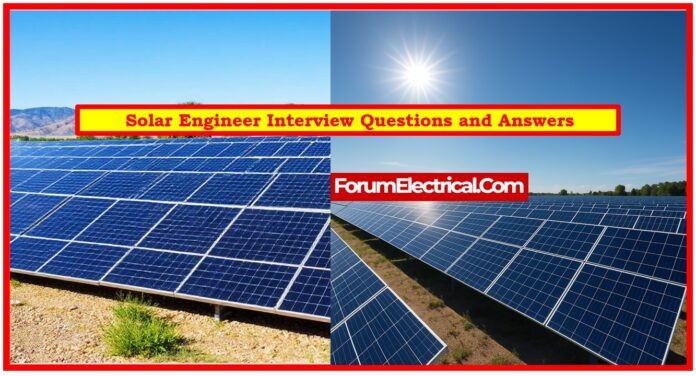1). What are the key components of a solar PV system?
- Solar panels,
- Inverter,
- Charge controller (in off-grid systems),
- Battery storage (if used),
- Mounting structure,
- Wiring, &
- Monitoring system.
2). What is the difference between a string inverter and a microinverter?
| String Inverter | Microinverter |
| A string inverter connects multiple panels in a series and converts DC to AC centrally. | A microinverter is installed on each panel and performs DC-AC conversion individually, improving performance in shaded (or) variable conditions. |
3). How do you calculate the efficiency of a solar panel?
Efficiency = (Power output/(Solar irradiance x Area)) x 100%
4). What are the types of solar panels?
- Monocrystalline,
- Polycrystalline, and
- Thin-film.
5). What is the role of a Maximum Power Point Tracker (MPPT)?
MPPT – Maximum Power Point Tracker optimizes the power output from a solar panel by adjusting the voltage and current to find the maximum power point.
6). What factors affect the output of a solar PV system?
- Sunlight intensity,
- Temperature,
- Shading,
- Orientation,
- Tilt angle,
- Dirt/dust on panels, and
- System losses.
7). Explain how net metering works
Net metering allows consumers to export excess solar power to the grid and receive credits, reducing electricity bills.
8). What is the significance of solar irradiance in system design?
It helps determine the potential solar energy a site can produce, impacting panel sizing and energy yield.
9). How do you perform a site assessment for a solar installation?
Evaluate
- Roof space (or) ground area,
- Solar access,
- Shading,
- Orientation,
- Tilt,
- Structural integrity, and
- Local regulations.
10). What are common solar system losses?
- Cable losses,
- Inverter losses,
- Shading losses,
- Temperature losses, and
- Mismatch losses between panels.
11). How do you size a solar PV system for a residential customer?
Based on energy consumption, available roof space, solar irradiance, and system losses.
12). What tools or software do you use for system design?
- PVsyst,
- HelioScope,
- AutoCAD,
- SketchUp,
- Homer Pro, and
- Excel.
13). What safety precautions should be followed during installation?
Use PPE, follow lockout/tagout procedures, check for live wires, use fall protection, and follow local electrical codes.
14). Describe the commissioning process of a solar PV system
Inspection of installation, system testing, inverter start-up, performance verification, and documentation.
15). How do you ground a solar PV system?
Ground the metal components and electrical system to prevent electrical shock and protect against lightning or faults.
16). How often should solar panels be cleaned?
Typically every 6–12 months, depending on dust, pollution, & bird droppings.
17). What are common faults in a solar PV system?
- Inverter failure,
- Loose connections,
- Panel degradation,
- Shading, and
- Ground faults.
18). How do you test for panel degradation?
Use I-V curve tracing, insulation resistance testing, and compare output over time with expected performance.
19). How do you monitor system performance?
Through monitoring systems or software that track generation, consumption, and faults.
20). What is the expected lifespan of a solar panel?
Typically 25–30 years with a gradual reduction in efficiency (usually ~0.5% per year).
21). What is a Solar Performance Ratio (PR)?
Performance Ratio is the ratio of actual energy output to the theoretical energy output.
Performance Ratio (PR) = (Actual output / Theoretical output) x 100%.
A higher PR indicates better system performance.
22). What are the environmental benefits of solar energy?
Solar energy
- Reduces greenhouse gas emissions,
- Decreases reliance on fossil fuels,
- Lowers air pollution, and
- Conserves water compared to conventional power generation.
23). How do shading and soiling affect solar panel output?
Shading significantly reduces panel output and can cause hotspot damage, while soiling (dust/dirt) reduces light reaching the cells, lowering efficiency.
Regular cleaning and proper layout help mitigate these.
24). What’s the difference between on-grid and off-grid solar systems?
| On-Grid Systems | Off-Grid Systems |
| On-grid systems are connected to the utility grid and may use net metering. | Off-grid systems operate independently using batteries for storage, typically in remote areas without grid access. |
25). How do you ensure compliance with local codes and standards in solar projects?
By referring to local electrical and building codes, obtaining required permits, following IEC/NEC/IS standards, and collaborating with certified professionals and authorities for inspections and approvals.









